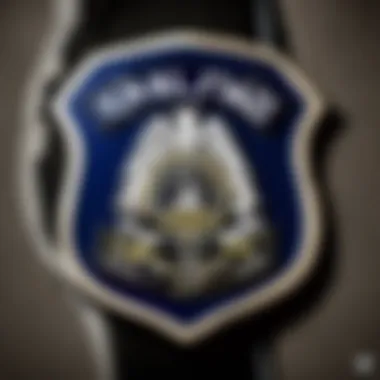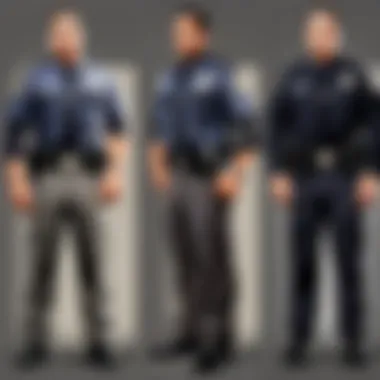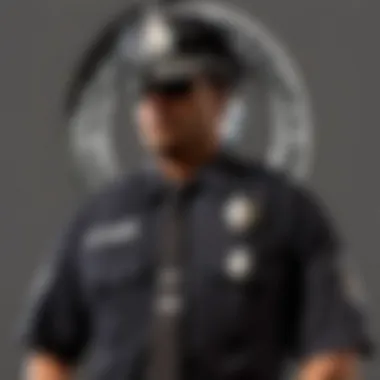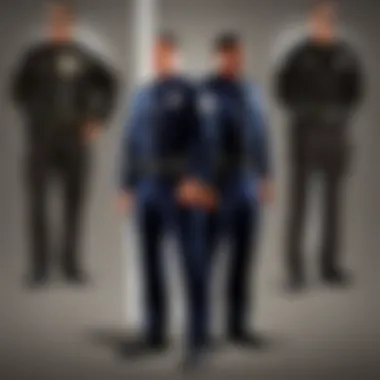Understanding the LAPD Uniform: A Detailed Review


Intro
The LAPD uniform holds a unique place in the landscape of law enforcement apparel. Its design and significance have evolved over decades, mirroring changes in societal views on policing and public safety. This article investigates the intricate elements of the LAPD uniform, from its historical background to the materials used, and its broader implications in contemporary society. An understanding of this uniform provides insight into the image of authority it projects and how it is perceived by the public.
History of the LAPD Uniform
The evolution of the LAPD uniform reflects significant moments in both law enforcement and cultural history.
Early Development
In the late 19th century, uniforms were primarily utilitarian, designed for function over style. The first uniforms were dark wool outfits, intended to convey a sense of authority and professionalism. These early garments were simplistic, often making it hard for officers to stand out in a crowd.
Mid-20th Century Changes
As media and public perception evolved, so did the LAPD uniform. In the 1950s and 1960s, the iconic dark navy blue became the standard. This color change was strategic; blue conveyed trust and professionalism, aligning the LAPD with other global police forces.
“A uniform is a symbol. It unifies the officers while signifying their duties and responsibilities to the public.”
Modern Transformations
Today, the LAPD uniform consists of various components, including a dark navy shirt, tactical pants, and a utility belt equipped with essential tools. Recent designs have integrated modern materials that enhance durability and comfort, as well as improve the function of the uniform while maintaining a professional appearance.
Significance of the Uniform
Uniforms serve as a pivotal component of policing. They are meant to instill confidence in the community while ensuring officers’ safety.
Symbolism and Authority
The LAPD uniform is more than just clothing; it embodies authority and responsibility. Its presence on the streets acts as a reassurance to citizens, while also establishing boundaries in law enforcement actions.
Public Perception
The public's perception can shift based on the visual cues provided by a uniform. Studies have shown that a well-maintained and professional appearance can positively impact community interactions.
Closure
In examining the LAPD uniform, one can appreciate not only its physical attributes but also its deeper meanings. This analysis highlights its evolution, significance, and the essential role uniforms play in law enforcement. Understanding these intricate details fosters a more profound respect for the men and women who serve in these capacities.
Preface to the LAPD Uniform
The LAPD uniform holds significant importance within the framework of law enforcement and community engagement. It serves not just as a functional outfit but also embodies authority, respect, and tradition. The visual impact of this uniform can influence public perception and foster trust between law enforcement and the community. To understand its relevance, one must explore its historical roots, design elements, and the overall role it plays in policing today.
Historical Context
The LAPD uniform has evolved considerably since its inception in the late 19th century. Initially, uniforms were designed primarily for practicality, prioritizing the need for durability and comfort. The first LAPD officers wore dark blue wool suits, which allowed for ease of movement while projecting a sense of seriousness. Over decades, these uniforms have adapted to reflect social changes and advancements in fabric technology.
In the 1920s, the LAPD adopted a new style influenced by military designs, which included distinct insignia and badges that identified officers clearly. By the 1950s, the uniform transitioned into a more formal and recognizable attire. This shift included the incorporation of specific features, such as the unique police hat that remains prevalent today. Understanding this historical progression is crucial, as it provides insights into how uniforms symbolize the values and mission of law enforcement over time.
Importance in Law Enforcement


The uniform functions as a powerful symbol of the law enforcement profession. It is an outward representation of authority and serves to establish a clear identity for officers on patrol. This is particularly important in densely populated urban environments where officer presence can either calm or escalate public interactions. The LAPD uniform distinguishes itself through the use of specific colors and design elements, which contribute to a sense of order and safety within the community.
Moreover, the LAPD uniform also plays a vital role in officer performance. Research indicates that when officers feel confident and comfortable in their attire, their efficacy increases. Uniforms that are designed for both appearance and functionality aid officers in executing their duties more efficiently. Additionally, a well-regarded uniform can enhance community relations by fostering an image of professionalism that earns public respect.
In summary, the LAPD uniform is far more than just clothing. It encapsulates a legacy that informs how both officers and civilians perceive their roles in society. Through its historical evolution and immediate implications for law enforcement practices, understanding this uniform unveils a wealth of insight into the broader implications of policing in modern society.
Design Elements of the LAPD Uniform
The design elements of the LAPD uniform play a critical role in establishing an identity that resonates with both the officers and the community. The uniform is more than just clothing; it is a representation of professionalism, authority, and commitment to public service. The choices made in the design process impact not only the functionality of the apparel but also how officers are perceived by the public. Through specific elements like color, fabric, insignia, and accessories, the LAPD uniform is a carefully crafted ensemble that serves multiple purposes.
Color and Fabric Choices
Color and fabric are foundational components of the LAPD uniform. Traditionally, LAPD uniforms feature a dark blue color, which stands out for its professional appearance while maintaining a sense of formality. The choice of color is significant, as it is often associated with law enforcement, symbolizing duty and integrity.
The fabric used in these uniforms must be durable and functional. Officers need clothing that can withstand the rigors of daily duty while also providing comfort during extended wear. Fabrics are typically lightweight and breathable to accommodate various weather conditions and physical demands.
Considerations such as moisture-wicking technology and stain resistance are also critical. These attributes help maintain a professional look throughout shifts. Overall, fabric choices represent a balance between resilience and comfort, crucial for officer performance.
Insignia and Badges
Insignia and badges are key features that add layers of significance to the LAPD uniform. Each badge has the officer’s rank and serves as an identification tool, differentiating between ranks and attributed responsibilities. This hierarchy brings structure to law enforcement operations, allowing the public to quickly recognize authority.
Additionally, insignia may include patches indicating specialty units or achievements. For instance, special task forces have unique insignias that differentiate their specific roles. These elements contribute to a visual narrative of an officer’s career and capabilities within the department.
The placement of badges and insignia follows strict guidelines, ensuring uniformity across the department. This uniformity is essential, fostering a cohesive image that reinforces trust and respect among the officers and the communities they serve.
Accoutrements and Accessories
Accoutrements and accessories complement the LAPD uniform, enhancing both functionality and professionalism. Utility belts are essential components, fitted with necessary tools like handcuffs, radios, and firearms. This arrangement isn't just about practicality; it also aids in ensuring officers are well-prepared to handle any situation that arises.
Other accessories, such as nameplates, are vital for establishing a personal connection with the public which can facilitate communication and officer accountability. Each piece of accessory is designed not only for purpose but also to uphold the uniform’s overall aesthetic.
Proper maintenance of these elements is crucial. Officers are expected to keep their uniforms clean and their gear in good working condition. Such adherence to uniform standards reflects the values of both the police force and the community, reinforcing the notion that law enforcement is dedicated to their duties and the populace.
"The LAPD uniform is more than just clothing; it is a powerful symbol of authority and commitment to the community."
Evolution of the LAPD Uniform Design
The evolution of the LAPD uniform reflects the changing dynamics of law enforcement and societal expectations. It illustrates how the uniform is not only functional but also serves as a significant symbol of authority and public trust. Understanding this evolution helps grasp the complexities of police culture and community interaction.
Early Uniforms and Their Features
In the late 19th and early 20th centuries, the initial LAPD uniforms were characterized by their heavy wool fabric and dark colors, primarily blue. This color choice was not arbitrary; rather, it symbolized professionalism and authority in the burgeoning urban landscape of Los Angeles. The uniforms typically included:
- Fitted jackets and trousers: These were designed for a neat appearance, conveying discipline.
- Brass buttons: They added to the officer's stature, enhancing the overall militaristic aesthetic.
- Basic insignia: Early uniforms featured minimal insignia, focusing instead on the officer's physical presence.
The simplicity was deliberate, aiming to convey a sense of order rather than dominance. As urban policing grew, these early uniforms laid the groundwork for future styles.
Changes in Style Over the Decades
Through the decades, the LAPD uniform underwent various transformations influenced by sociopolitical factors and advancements in fabric technology. Notably, the 1940s and 1960s mark significant shifts:


- Post-World War II: Fabric innovations introduced lighter materials that made uniforms more comfortable and suitable for the growing number of patrol duties.
- 1960s civil rights movements: Uniforms began to adapt to public sentiment, reflecting the changing relationship between police and communities. Emphasis shifted towards a more approachable appearance.
These modifications not only improved functionality but altered public perception. Officers began to be viewed not only as authorities but as community members.
Modern Innovations in Uniform Design
In recent decades, the LAPD has embraced modern innovations in uniform design that enhance both utility and officer dynamics. This includes:
- Performance fabrics: Modern uniforms use breathable materials that facilitate better movement and comfort.
- Reflective materials: Essential for nighttime visibility during patrols, enhancing officer safety.
- Tactical vests: These have been integrated into the uniform, providing officers with necessary equipment without compromising mobility.
Furthermore, the incorporation of body-worn cameras and other technology directly into the uniform design represents a progressive approach to transparency and accountability. The uniform now not only represents authority but also a commitment to modern policing ethics.
As a result, the LAPD uniform continues to evolve in response to the surrounding environment, reflecting both the practical needs of law enforcement and the expectations of the community. This ongoing evolution emphasizes that uniforms are more than just clothing; they signify complex relationships between police forces and the communities they serve.
"A police uniform is a public symbol of safety and authority. It communicates a commitment to serve and protects."
This evolving nature of the LAPD uniform encourages a discussion about the balance between tradition and contemporary needs, setting a framework for future improvements.
Role of the LAPD Uniform in Public Perception
The LAPD uniform plays a critical role in shaping public perception. It is not just a piece of clothing; it embodies authority, trust, and the commitment of law enforcement to uphold the law. Citizens often judge law enforcement based on appearances. The uniform acts as a visible symbol of the power and responsibility that comes with policing. This notion is crucial in outlining how the LAPD seeks to create an image that commands respect and instills confidence among the community.
Symbol of Authority
The LAPD uniform is primarily a symbol of authority. Its design is rooted in tradition and functionality, which reinforces the officers' role in maintaining law and order. The distinct navy blue color is synonymous with police work, providing a clear visual cue of law enforcement presence. In high-stress situations, the sight of a uniformed officer can convey security and order to the public.
Moreover, the uniform differentiates officers from civilians. This distinction fortifies the understanding that police serve the public, creating an atmosphere of safety. Officers in uniform can effectively manage crowd behavior during events and protests due to this inherent authority that the uniform provides.
"Uniforms represent the institution, serving as a reminder to citizens of who is there to protect them."
Influence on Community Relations
The way people perceive the LAPD uniform directly influences community relations. A police uniform can either foster trust or breed distrust. Misunderstandings or negative experiences with law enforcement can alter how a community views its officers. For instance, in communities where there is cooperation between police and residents, the LAPD uniform can symbolize partnership, respect, and support.
However, when tensions arise, the uniform can transform into an emblem of oppression or authority that is not well-received by some groups. Therefore, the LAPD must consider feedback from diverse communities when it comes to the uniform's design and image.
The LAPD has adopted various outreach efforts over the years. Initiatives aimed at improving community engagement and breaking barriers often coincide with uniforms. Friendly interactions between officers and citizens in casual settings help humanize the uniform.
LAPD Uniform in the Context of Law Enforcement
The LAPD uniform plays a crucial role in the broader context of law enforcement, serving as a unique representation of identity, authority, and function within the community. The uniform is not merely a set of clothes; it embodies the values and practices of the department. Understanding this context leads to greater insight into how uniforms influence both police interactions and community perceptions.
Comparison with Other Police Agencies
When examining the LAPD uniform, it is essential to consider how it stands in contrast to those worn by other police agencies. For instance, many law enforcement uniforms in the United States often feature variations in color and design. The New York Police Department utilizes a navy blue uniform, similar to the LAPD, but their insignia and accessories differ significantly.
Moreover, police uniforms in European countries, like the British Metropolitan Police Service, are characterized by their distinctive hats and tactical attire, which reflects a different cultural approach to policing.
In comparing these uniforms, factors like community expectations, historical evolution, and operational needs come into play. Each agency develops its own identity through uniform design, which directly impacts how officers are perceived by the public.
International Perspectives on Police Uniforms


Globally, the perception and function of police uniforms vary greatly. In many countries, such as Japan, police uniforms are often more formal and less militaristic. They prioritize visibility and approachability, aiming to foster a relationship with the community rather than imposing authority. On the other hand, uniforms in countries facing higher crime rates might lean towards a more tactical appearance, emphasizing security and deterrence.
"Uniforms function not just as clothing but as a critical tool in establishing authority and trust, which is vital in law enforcement contexts."
Each nation’s approach reflects its historical context, societal norms, and the role of law enforcement within that society. In South America, for example, tactical gear is prevalent due to higher crime levels, whereas Scandinavian countries tend to favor minimalistic designs that promote accessibility and engagement.
Practical Considerations of the Uniform
The LAPD uniform serves several practical purposes that go beyond mere style. Its design must support the functionalities required for effective policing. As police officers engage in a variety of scenarios, the uniform needs to provide both comfort and utility. Understanding these practical considerations can shed light on how the LAPD uniform is not just a visual identifier but a tool that enhances an officer’s capacity to perform their duties efficiently.
Comfort and Functionality
Comfort is a crucial aspect of the LAPD uniform. Given the demanding nature of police work, officers can find themselves in various conditions for long periods. For instance, the material used in the uniform must be breathable and flexible, allowing for a full range of movement. Fabrics that wick moisture away are fundamental, especially during hot Los Angeles summer days.
The uniform typically features ergonomic designs and tailored fits. This is essential, as officers often need to run, crouch, or maneuver in tight situations. Adjustments like lightweight materials for jackets and pants can significantly impact comfort levels.
Some key aspects of comfort in the LAPD uniform include:
- Breathable fabrics: Helps regulate body temperature and prevent overheating.
- Adjustable fits: Accommodates different body types and personal preferences.
- Lightweight construction: Reduces fatigue during extended duty hours.
These elements not only make the uniform more comfortable but also allow for greater focus on the job at hand, rather than distractions from physical discomfort.
Impact on Officer Performance
The role of the uniform in influencing officer performance cannot be overstated. A functional and comfortable uniform can enhance an officer's efficiency and effectiveness in various situations. When officers wear uniforms that allow them to move freely and stay comfortable, they can respond more rapidly to emergencies and engage in community interactions more positively.
Additionally, the practical design of the uniform includes pockets and attachments for essential equipment. Officers often carry tools such as radios, handcuffs, and other necessary gear. Easy access to these tools can make a substantial difference in tense situations.
Specifically, practical design features may include:
- Strategically placed pockets: Important for quick access to tools and essential gear.
- Durable materials: Ensures longevity amidst wear and tear from daily duties.
- Visibility elements: Bright insignia and reflective materials increase safety during night operations.
In summary, the practical aspects of the LAPD uniform play a vital role in ensuring that officers perform at their best. Beyond aesthetics, the design prioritizes comfort and functional utility, paving the way for better engagement with the community and effective law enforcement.
Culmination: The Future of the LAPD Uniform
The discussion around the LAPD uniform is essential, not only for understanding its historical significance but also for assessing its future role in law enforcement. As society evolves, so does law enforcement attire, reflecting changing attitudes and expectations about police presence and professionalism. The LAPD uniform must adapt to these shifting dynamics while maintaining its core identity.
Trends in Law Enforcement Attire
Contemporary trends in law enforcement attire show a movement towards practicality and inclusivity. Officers across the United States are increasingly opting for uniforms that promote comfort and tactical functionality. This shift often incorporates moisture-wicking fabrics, enhanced mobility options, and designs that facilitate a less militarized public presence.
There is also a growing emphasis on customizing uniforms for diversity among officers. The rationale here is clear: a standard uniform might not accommodate different body types or cultural requirements effectively. This consideration presents an opportunity for police departments, including the LAPD, to invest in varied uniform lines that represent their commitment to inclusivity.
- Moisture-Wicking Fabrics: Enhances comfort during long hours.
- Custom Fits: Address needs of diverse personnel.
- Professional Appearance: Remains crucial for public perception.
Integrating Tradition with Modern Needs
Balancing tradition with modern expectations is critical for the future of the LAPD uniform. The historical designs hold immense value, symbolizing authority and continuity. However, as public interactions evolve, there is a distinct need for uniforms that modernize the message conveyed by officers. This requires a thoughtful blend of traditional elements with innovative materials and design philosophies.
For instance, integrating high-visibility features can improve officer safety without sacrificing the timeless look of the uniform. Using technology, such as embedded body cameras or smart fabrics with real-time data tracking, aligns with the law enforcement shift towards transparency and community engagement.
"The LAPD's uniform must not only serve as a symbol of authority but also as a beacon of trust and approachability."
The future’s direction will likely require feedback from the communities the LAPD serves, ensuring that uniforms reflect not only the department's legacy but also its commitment to service and accessibility. The challenge will be retaining the uniform's essence while embracing advancements that benefit officer and public alike.
In summary, the LAPD uniform stands at a crossroads. By focusing on trends in law enforcement attire and finding ways to integrate modern needs with traditional values, the LAPD can continue to represent the authority it embodies while fostering better relationships within the community. This evolving narrative will help ensure that the uniform remains relevant and respected in the years to come.



